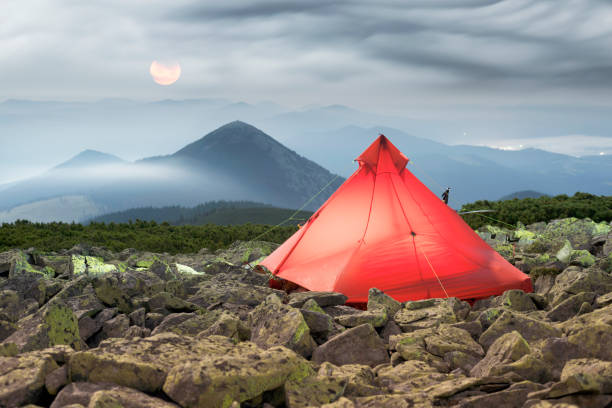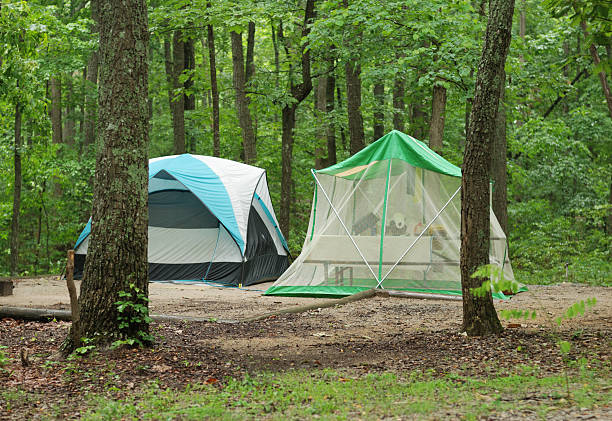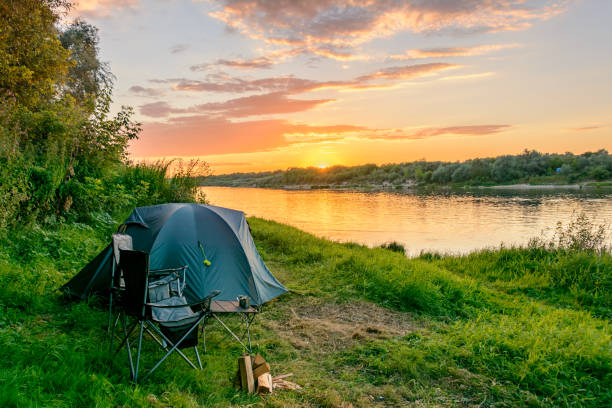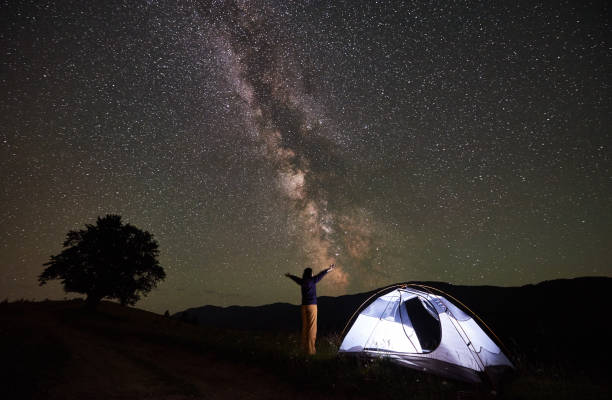I’ll never forget the first time we got caught in an unexpected windstorm while tent camping in high winds. One moment we were roasting marshmallows by the fire, and the next, we were scrambling to hold our tent down before it flew into the trees. Ever since then, we’ve made it a mission to test out tents that can handle serious gusts without flinching. From quick pop-up domes to spacious family lodges, we’ve taken these high wind tents out into real windy backcountry situations to see how well they actually hold up.
Each tent on this list is the best tent for high winds. Each has been pitched by us—sometimes on rocky slopes, other times in exposed valleys with wind speeds that made us double-check the stakes twice. We’ve huddled inside during downpours, zipped up every flap in the face of a gale, and even used some of these tents as sun shelters when the wind finally died down. The point is, these aren’t just product specs and polished ads—we actually used these tents. So if you’re planning camping in high winds, stick around. These seven rugged tents might just save your trip from becoming a kite-flying disaster.
Table of Contents
- Purebox Tent for Camping
- CAMPROS CP Tent
- ArkTrek 6 Person Tent
- Toncoke Tent for Camping
- Forceatt Camping Tent
- UNP Camping Tent
- Toogh Camping Tent
- Our Verdict!
- How to Choose the Best Tents for Tent Camping in High Winds
- Low Profile & Aerodynamic Shape
- Strong Poles & Reinforced Structure
- High-Quality Fabric & Anchoring Options
- Can tents withstand high winds?
- How windy is too windy for camping?
- Should you face your tent into the wind?
7
Purebox Tent for Camping
We took the Purebox Tent for Camping along on a beachside camping trip where the winds whip across the dunes like clockwork every afternoon. What struck us right off the bat was how insanely fast this thing popped up—less than a minute from backpack to pitched. The hydraulic system was a breeze to operate, and we didn’t have to fumble with a mess of poles.
The double-layer design was what really won us over in terms of wind resistance. Once the outer layer was clipped down with the guy lines and stakes (which are surprisingly sturdy for how lightweight they are), the tent transformed from a floppy little dome to a stable shelter. It stayed surprisingly firm even when the gusts kicked up sand like a desert storm.
Inside, the space felt generous for two of us plus our gear. I’m 5’9”, and lying down didn’t have my head or feet brushing up against the ends. We especially liked the adjustable front and rear ventilation—on a warm, breezy night, it helped keep the airflow nice without letting bugs in. And on hot afternoons? We unclipped the inner tent and used the outer shell as a makeshift sunshade while we relaxed with a drink.
Would I trust this tent on a weeklong trek in unpredictable mountain weather? Probably not. But for backyard camping, beachside lounging, or car camping in fair weather with occasional wind—it’s a winner. Quick, versatile, and reliable for light to moderate conditions.
Pros:
✅ Incredibly fast setup with hydraulic pop-up system
✅ Double-layer design for better wind and water protection
✅ Converts into a sunshade for versatile use
✅ One of the superb tents for high wind and rain
Cons:
❌ Not ideal for rough multi-day wilderness trips
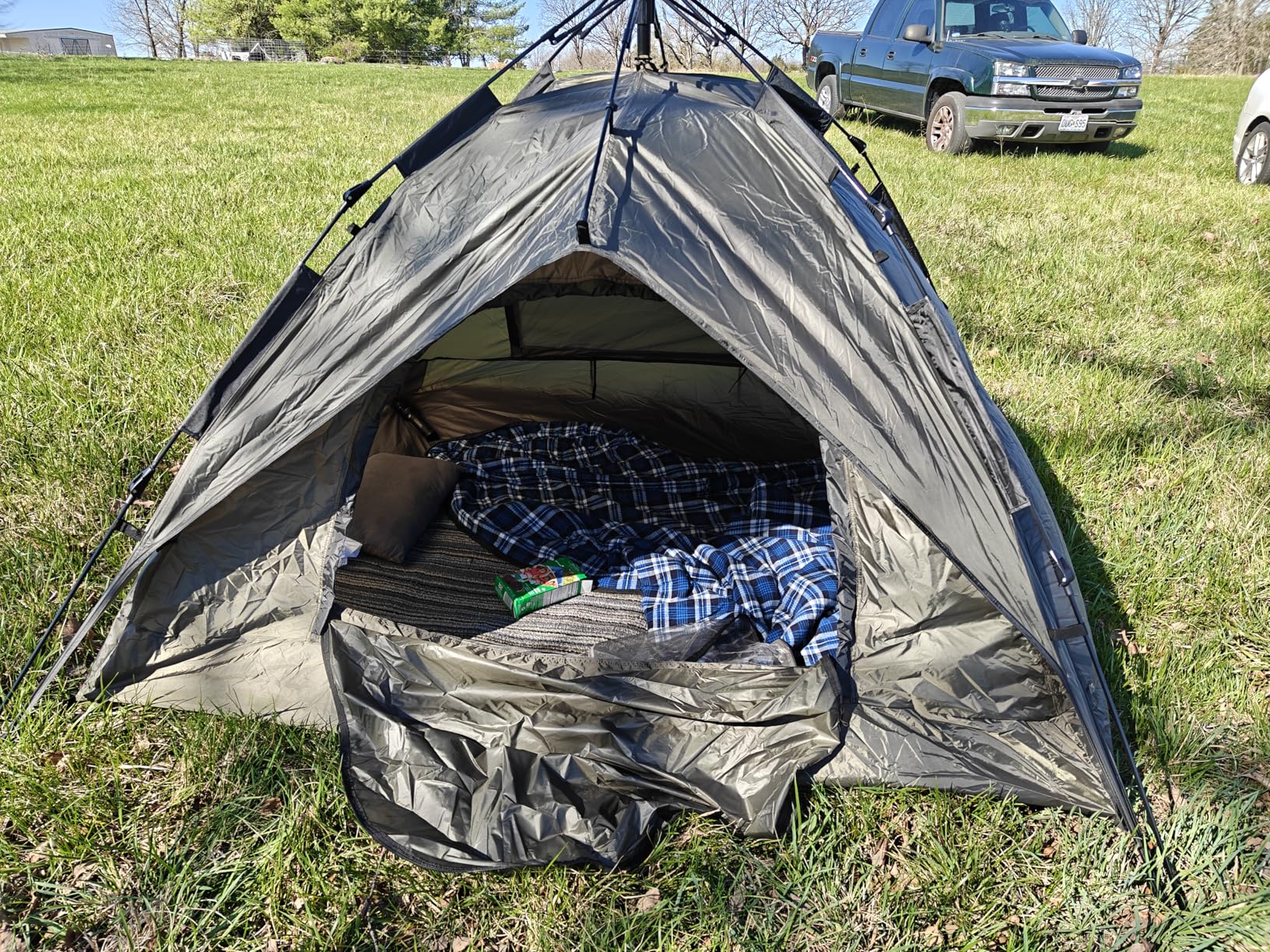
6
CAMPROS CP Tent
Best Value for Money. This monster of a tent came with us on a group camping trip up in the hills—windy ridgelines, tall pines, and nowhere to hide from the elements. We were skeptical at first. A 12-person tent standing up to high winds? But the CAMPROS CP Tent proved it’s more than just a big family tent—it’s a fortress with a lot of personality.
Setup was smooth, even for a tent this size. Two of us handled it in about 10 minutes thanks to the color-coded poles. The only hiccup? Figuring out which way the rainfly should face—turns out, “Campros” on the fly should be to the right of the front door. Lesson learned.
We had rain, wind, and chilly night temps, but the 185T polyester with PU1000mm coating didn’t let a drop inside. The seams and rain strips held tight. And even during wind gusts that rattled the trees, the tent barely flinched—just a steady flap of the fly and some creaks in the poles, nothing alarming. We dug a shallow trench around it as a precaution (always a good habit), but the built-in flooring lips already did a great job channeling water away.
The highlight? The three-room layout with dividers. At night, it felt like a sleepover fort. One room for sleeping, one for our gear and cooking supplies, and one for just hanging out. Plus, the ceiling is high enough that I could almost stand up fully—and I’m 6’6″! The large mesh windows and ceiling gave us stunning star views after the wind died down.
Honestly, for group camping—even in tough weather—this best tent for strong winds felt like a cozy lodge. Just make sure you’ve got enough flat space to stake it out fully.
Don’t miss out on the detailed review of the product by Living Our American Dream on YouTube.
Pros:
✅ Spacious enough for large families or groups
✅ Handles wind well when fully staked
✅ Great ventilation with mesh roof and windows
Cons:
❌ Requires a large, flat area for proper setup
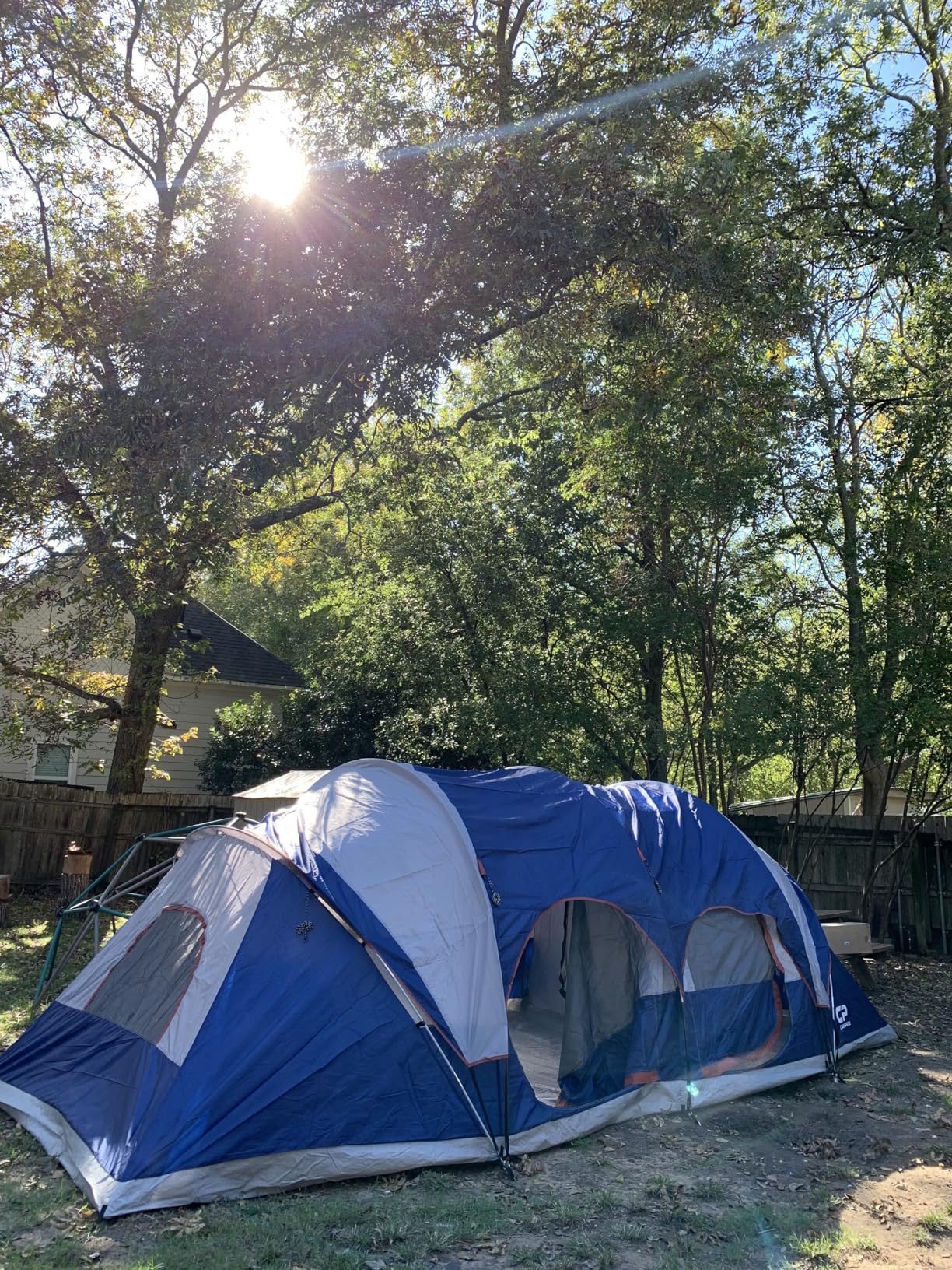
5
ArkTrek 6 Person Tent
Best Sturdiness. We brought the ArkTrek 6 Person Tent along for a mid-altitude camping high winds trip where sudden bursts of wind were part of the forecast. It was one of those times where we weren’t sure what the weather would do next, but this tent didn’t let us down.
The first thing we noticed was the solid 11mm poles—they weren’t just for show. Once the tent was up and tied down, it didn’t budge even when the breeze turned into a full-on gusty evening. The sealed joints and thick 210D Oxford fabric gave us confidence that we weren’t going to wake up soaked or sleeping on a collapsed mess.
The front door zipped smoothly, and we loved the little welcome mat outside. It’s a small detail, but when you’re constantly stepping in and out, it helps keep mud and sand where it belongs—outside. There was even a power port so we could charge our phones from a battery pack without leaving a zipper cracked open.
Inside, it was roomy enough for four of us and some gear, though I’d say six would be tight. The pockets and central hook were perfect for organizing our stuff and hanging up a light after dark. The only downside? One of our pole cords snapped during take-down. But their customer service team got back to us quickly and offered a refund—even past the return window.
If you want a sturdy, easy-up tent that won’t quit in gusty conditions, this is no doubt one of the top tents that can withstand high winds, and should be on your radar. It felt like a great mix of convenience and strength.
P.S. You might also be interested in Instant Screen Tent with Floor? See Our Top 7 Picks!
Pros:
✅ Thick Oxford fabric and sealed joints withstand surprise storms
✅ Smooth zippers and welcome mat add comfort
✅ Helpful internal storage and power port access
Cons:
❌ Shock cord in poles may break under tension
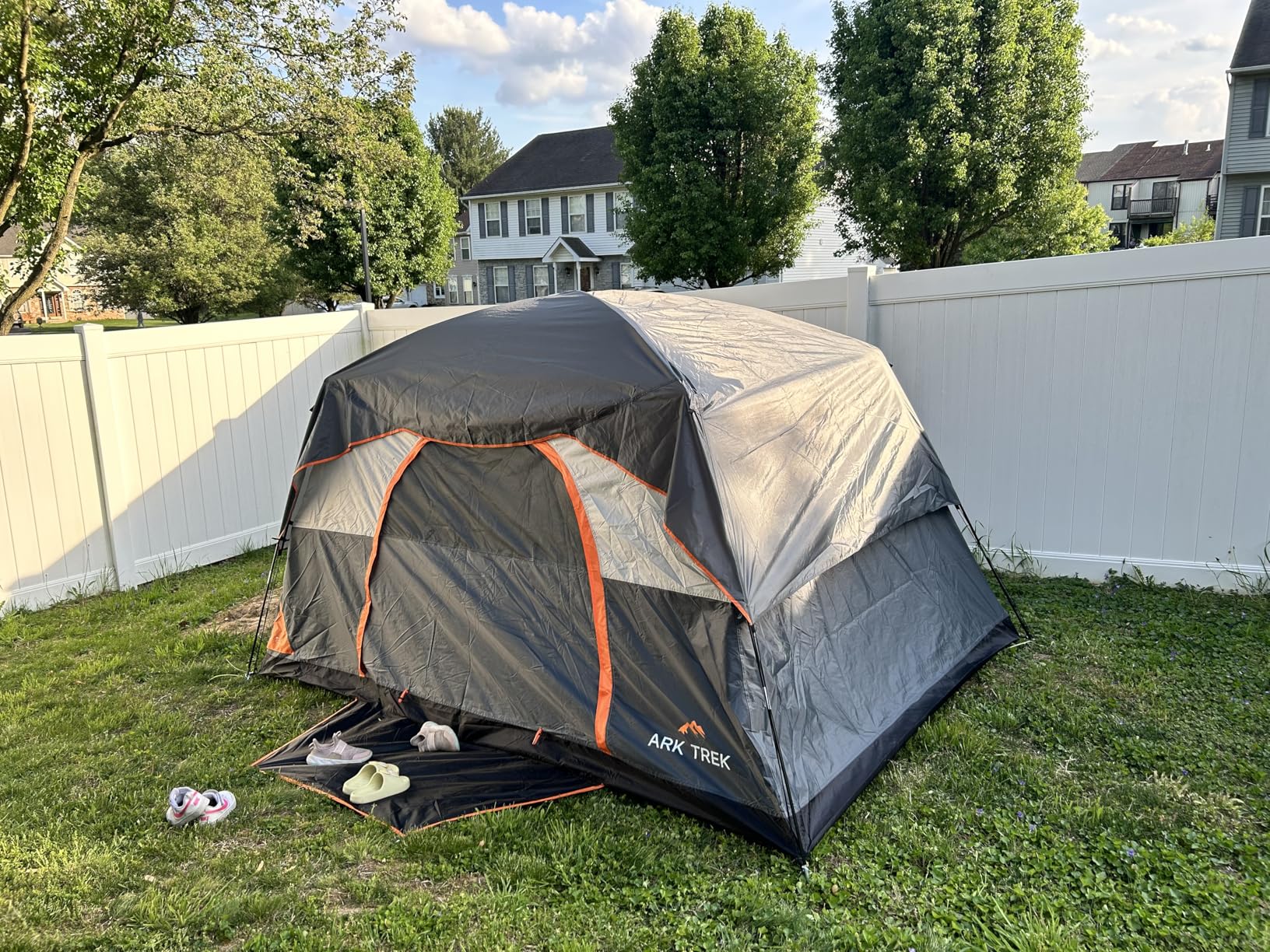
4
Toncoke Tent for Camping
This one was our wild card. We weren’t expecting much from the Toncoke Tent for Camping when we tossed it into the trunk before a scout camp weekend. But when one of the other tents flooded out during a late-night thunderstorm, we had to pitch this one fast—in the dark, in the rain, under serious wind.
And it delivered.
Thanks to its umbrella-style pop-up system, we had the whole thing up and rainfly attached in under two minutes, with nothing but headlamps and muscle memory guiding us. Having the best tent design for high winds, the 8.5mm fiberglass poles were thicker than most we’ve seen, and that made a big difference when the wind was howling. Even without a big vestibule, the sidewalls held firm and we didn’t see a single leak.
Ventilation was solid too. The mesh doors and windows let in a cool cross-breeze once the rain cleared, and the inner layer zippers were smooth and reliable. It’s not a massive tent—comfortable for two people and gear, or three people if you pack light—but the compact size actually helped in windy conditions. Less surface area meant less shaking around.
By the end of the trip, we were calling it the “scout saver.” It packed down small, carried easily, and despite a few quirks like vague fold-up instructions (just follow the yellow tape at the joints!), it proved itself worthy. For emergency use, short trips, or anyone looking for a fast-deploying tent with real grit, this one’s a champ.
Pros:
✅ One-person instant setup with pre-installed poles
✅ Stronger poles than most in its class for wind resistance
✅ Compact and packs down surprisingly small
Cons:
❌ Tight fit for three people with gear inside
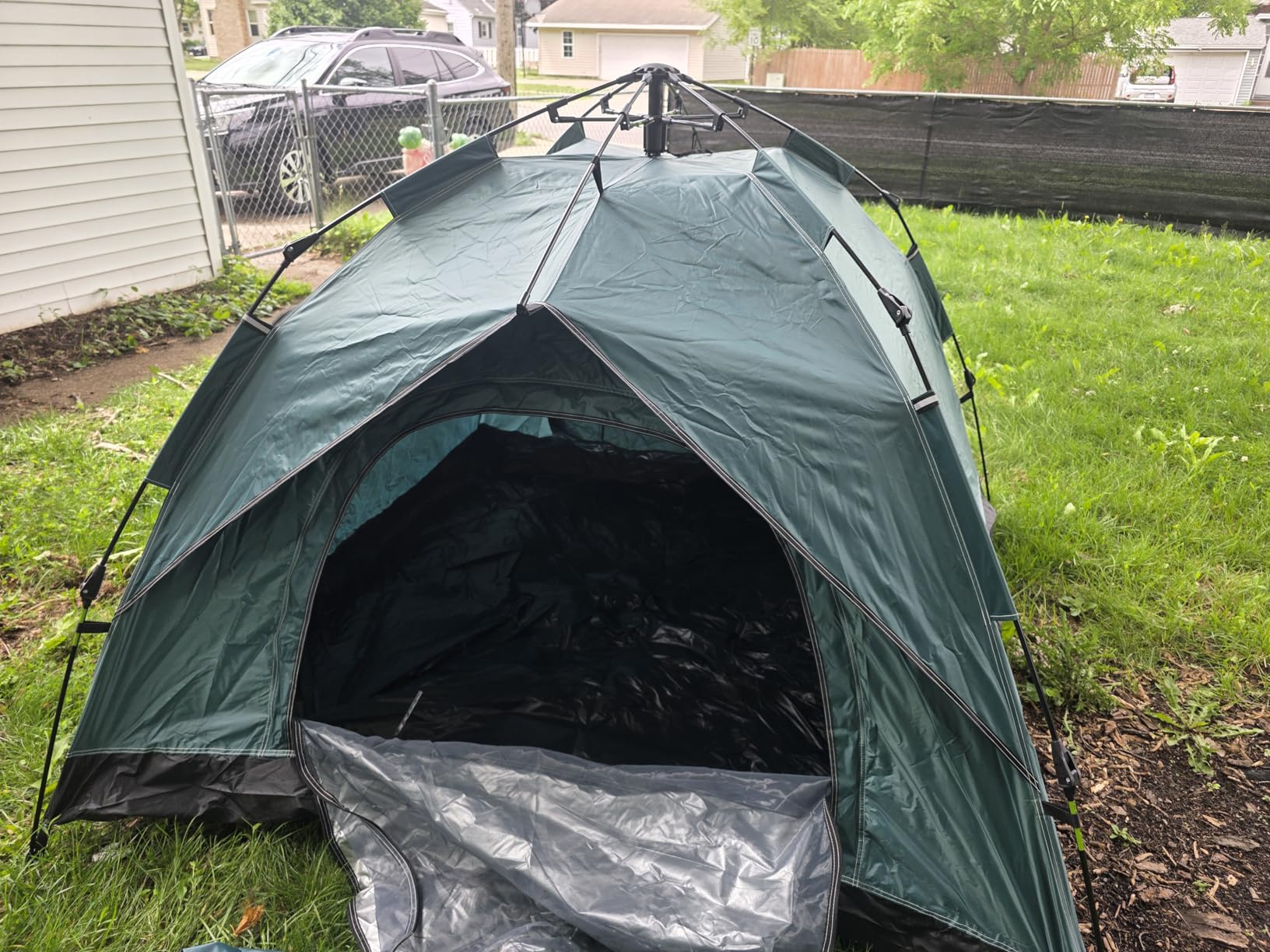
3
Forceatt Camping Tent
When we planned our backcountry tent camping in high winds and trekking through the high plains—where the winds sweep across the ridges like freight trains—we knew we needed something compact but tough. Enter the Forceatt Camping Tent. We packed it as our two-person shelter, and man, did it punch above its weight.
Weighing just over 5.5 pounds, this tent didn’t weigh us down during the hike, and once we picked our site, we had it up in less than five minutes, even with the wind starting to push against us. The setup was intuitive—just a few clips and the aluminum poles locked right into place.
We were immediately impressed with how taut the structure felt. The 70D polyester shell combined with the 7001 series aluminum poles made it feel like a bunker against the wind. We staked down all four corners and added the extra wind ropes for good measure. That tent didn’t budge, even when the wind howled through the valley like it had a grudge.
Inside, it felt snug but efficient. We had room for two people and a few essentials—our boots, packs, and even our dog curled up at our feet. The two D-shaped doors were a smart touch—we didn’t have to climb over each other for midnight bathroom runs. The double vestibules gave us a dry spot to stash gear, and the ceiling vents and mesh window kept the airflow moving, even when zipped tight.
This tent feels like it was designed by folks who actually camp in tough conditions. It’s not a luxury hotel, but for windy nights in the wild, it gave us peace of mind—and dry sleeping bags. Total win.
Also, you may be interested in our exclusive roundup of The Top Family Camping Tents: Space, Comfort & Easy Setup.
Pros:
✅ Lightweight and compact for easy backpacking
✅ Strong aluminum poles and welded floor handle high winds
✅ Dual doors and vents keep air flowing
Cons:
❌ Limited interior space—best for two people max
2
UNP Camping Tent
We took the UNP Camping Tent out on a weekend trip with another couple and their kids. The goal was comfort, space, and something that wouldn’t turn into a wind-blown balloon if the weather acted up. This tent delivered—big time.
First off, the thing is tall. Like, standing-room-tall. At 78 inches, we could stand upright to change clothes or move around without crouching like goblins. That alone made it feel more like a cozy room than a tent. And it truly is spacious—we fit a queen air mattress and a full cot with room to spare for duffel bags and a small table.
The setup was painless—two of us had it fully pitched in about five minutes. The steel leg poles felt solid, and the rectangular roof design added extra stability. And when the wind picked up on the second night, we were genuinely surprised at how well this big boy held firm. Our friend’s smaller tent was doing the cha-cha with every gust, but ours barely wobbled. Those thick poles really make a difference in wind-prone zones.
Ventilation was another high point. The large mesh door, five windows, and mesh roof allowed the breeze to flow through during the warm day, and at night, we clipped a lantern to the ceiling mesh hammock and had ourselves a proper camp lounge.
The only gripe? The single zipper on the door. It’s a long C-shaped track that you’ve got to zip up completely each time—would’ve been nice to have a double zip. But honestly, everything else outweighed that minor annoyance.
By the end of the weekend, everyone was peeking into our tent, a little envious of how comfortable and steady it was. If you want a spacious tent that holds its ground in gusty weather, this one’s a keeper.
You might also want to browse the official brand website for more interesting options.
Pros:
✅ Sturdy frame and tall design stand firm in windy weather
✅ Comfortable height for standing and moving around
✅ Excellent airflow and storage pockets
✅ The best family tent for high winds
Cons:
❌ Single door zipper is long and prone to wear
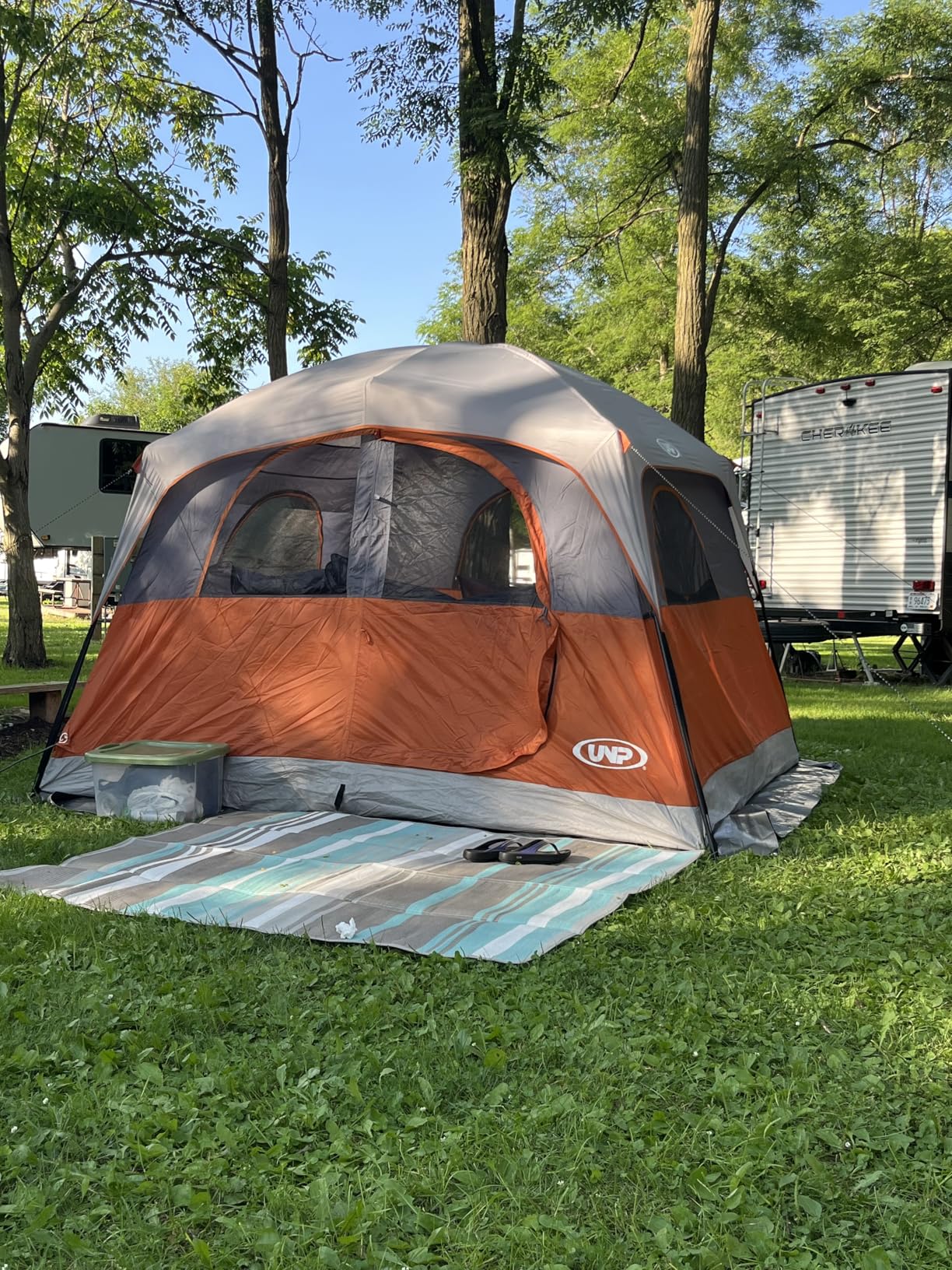
1
Toogh Camping Tent
Best Overall. Our top pick for wind-resistant ease and practicality? That honor goes to the Toogh Camping Tent. This thing made an impression the moment we pulled it out at a lakeside campsite with open fields and zero windbreaks. It was a bit of a gamble—wide open exposure—but this tent proved it could hang tough.
Setup was lightning-fast. One minute flat, and we had the telescopic poles locked in place. No wrestling with sleeves or tangled clips. Just lift, extend, and boom—it’s ready. For solo campers or parents juggling kids and gear, this is a dream.
The Oxford cloth feels solid to the touch—denser than most budget high wind camping tents—and the PU-taped seams and welded floor corners kept us bone-dry through an overnight rainstorm. Water pooled around the tent, but not a single drop crept inside. We were impressed, especially at this price point.
Inside, the 8×8 floor plan comfortably fit a queen air mattress and still gave us room to move. The 67-inch peak height was tall enough for most of us to stand while changing—no awkward hunching. We also liked the multiple mesh windows and roof vents. It got warm during the day, and while there’s limited airflow near the ground, the cross-breeze from the upper mesh panels kept us from overheating.
This tent also stood its ground surprisingly well in heavy gusts. We made sure to secure all the guy lines and double-check the stakes, and once tightened, the whole structure barely flinched. The rainfly does take a little effort to drape on (especially if you’re short like me), but the coverage is excellent once it’s in place.
We ended up using it not just for sleeping but as our changing room and gear locker during the day. It was like having a mini cabin on site. If you’re looking for a wind-resistant, no-fuss tent with quick setup and solid weatherproofing, the Toogh deserves a spot on your list.
Pros:
✅ 60-second setup with telescopic poles
✅ Dense Oxford fabric and PU seams stay dry in storms
✅ Great peak height and full mesh top for airflow
Cons:
❌ Rainfly installation can be tricky for shorter users
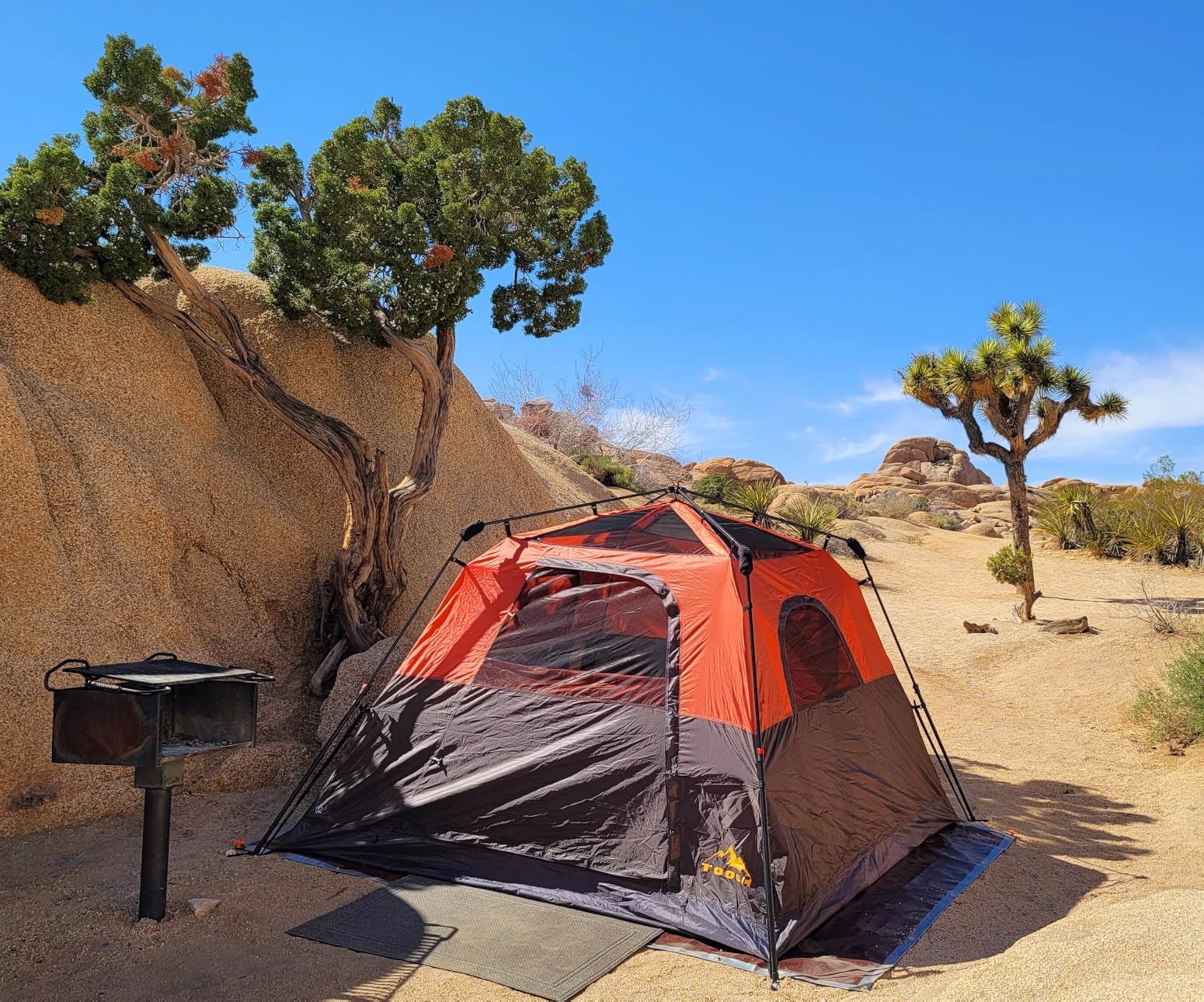
Our Verdict!
From the above roundup of the top options for tent camping in high winds, the Toogh Camping Tent turned out to be the Best Overall option among high wind resistant tents given its top class performance, price and the overall value it offered us. Having said that, we also picked two other options that stood out in one specific feature very easily. Let’s have a look at them below!
- Best Value for Money: CAMPROS CP Tent
- Best Sturdiness: ArkTrek 6 Person Tent
How to Choose the Best Tents for Tent Camping in High Winds
When you’re heading into the wild where the wind howls and the trees sway, your tent needs to be more than just a place to sleep—it needs to be your shelter, your shield, your stronghold. Choosing the right tent for tent camping in high winds is all about smart design, solid materials, and trustworthy engineering. Here are three key features to look for:
✅ 1. Low Profile & Aerodynamic Shape
Tall, boxy tents might be roomy, but they’re also wind magnets. For high winds, you want the best tent for strong winds that hugs the ground—think dome-shaped or low-slung designs that let the wind roll over them instead of fighting against it. Fewer flat surfaces mean less flapping and more stability when the weather turns fierce.
✅ 2. Strong Poles & Reinforced Structure
In heavy wind, your tent is only as good as its frame. Look for aluminum or thick fiberglass poles, cross-pole systems for added tension, and plenty of guy-out points. Tents that include extra wind ropes or have X-style pole layouts tend to hold firm when the breeze turns brutal.
✅ 3. High-Quality Fabric & Anchoring Options
You need more than a thin layer of fabric between you and the storm. Go for best tent for high winds made from ripstop nylon or tough polyester with reinforced seams and a good hydrostatic rating. And don’t forget the stakes—strong stakes and solid anchor points can mean the difference between a tent that stays put and one that sails into the next valley.
Can tents withstand high winds?
Yes, tents can absolutely withstand high winds—but only if they’re built for it and set up correctly. Not all tents are created equal; while lightweight festival tents might crumple in a strong breeze, well-designed camping tents with aerodynamic shapes, sturdy poles (like aluminum or reinforced fiberglass), and multiple guy-out points can stand firm even in 40–60 mph gusts. Dome or geodesic-style tents tend to perform best because they distribute pressure evenly across the frame. Proper setup is just as important: securing all stakes, tightening guy lines, and choosing a sheltered pitch location (like behind natural windbreaks) can drastically improve your tent’s resilience. When you’re tent camping in high winds, it’s not about brute strength—it’s about smart design, solid construction, and good preparation.
How windy is too windy for camping?
When it comes to tent camping in high winds, anything over 30 to 40 mph winds starts pushing the danger zone, especially if you’re using standard recreational tents. At this level, even sturdy gear can begin to sway, stakes may loosen, and you’ll hear that dreaded flapping sound all night long. Once winds exceed 50 mph, most high wind camping tents—unless they’re specifically designed for extreme conditions—risk collapsing, tearing, or even getting airborne. But it’s not just about the tent; flying debris, falling branches, and shifting weather can turn a scenic campsite into a hazardous zone fast. If the wind forecast is consistently above 40 mph, it’s wise to delay your trip, switch to a more sheltered location, or make sure you’ve packed a tent tested for harsh wind loads. As thrilling as nature can be, safety should always camp first.
Should you face your tent into the wind?
Not exactly! While it might seem logical to face your tent door into the wind for airflow, in high-wind conditions, that’s actually a recipe for trouble. The best strategy is to position the lowest and narrowest end of your tent—the foot or back side—into the wind. This helps the wind glide over and around your shelter rather than slamming into a flat surface like the door or sidewalls, which could cause flapping, damage, or even collapse. If your tent has a sloped profile, align it so the slope cuts through the wind like an aerodynamic wedge. And whatever you do, avoid facing the door directly into strong winds—it can turn your cozy space into a wind tunnel and even stress the zippers or seams. Smart positioning, along with secure staking and guy lines, will keep your tent grounded and intact when the gusts come roaring through.
